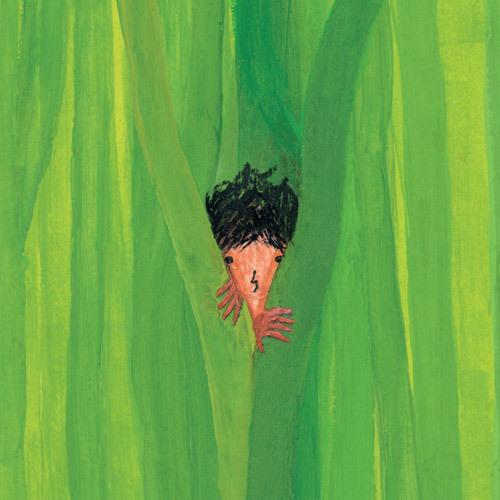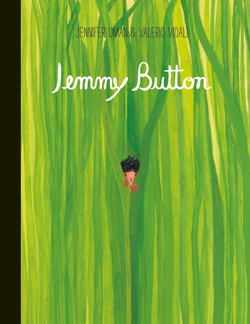< Back to posts
Valerio Vidali
Italy

Valerio Vidali is an Italian illustrator who lives in Berlin. He was a winner of ILUSTRARTE: the Biennial of Children's Book Illustration in Portugal, and the CJ Picture Book Awards in Korea. Valerio has been selected for the Bologna Illustrators Exhibition four times and his work has been published in more than a dozen countries.
In this post, Valerio talks about the creation of ‘Jemmy Button’, which is the result of his fascinating collaboration with American artist, Jennifer Uman. This beautifully illustrated picturebook is based on the true story of a native boy from Tierra del Fuego, who was brought to England in the mid-1800s to be ‘educated’ and ‘civilised’.
Valerio: I received the first email from Jennifer on June 12th, 2008. It contained a delightful small painting on canvas, depicting a grey-haired gentleman holding a tiny red cat in his hand. Jennifer told me that even though we didn't know each other, I had been the inspiration for the painting. Me, of all people! She assured me it was true. The email was written in a bizarre and surreal Italian. Jennifer had seen my work and liked it – and realising I couldn't speak any English, she resorted to Google Translate.
As I had the chance to observe, Jennifer is a formidable self-taught painter with a unique language and sensibility. In addition to the ‘colour’ the translations added to our conversations, I was surprised and amused by her way of speaking and being. Almost without realising it, I found myself waiting impatiently for her next email. At an almost daily pace, Jennifer told me about New York, about the films of Satyajit Ray and Horace Pippin, and about the birds singing outside her window. I talked to her about Barcelona, El Raval, my stolen bike, Botero's cat and, amongst many other things, about Jemmy Button.
Jemmy Button was a child from the Yamana tribe (a native from Tierra del Fuego), who was taken hostage and brought to Europe in 1830 by Captain Robert FitzRoy aboard the HMS Beagle (the ship that later became famous for accompanying Darwin on his voyages). The kidnapping was planned as punitive retaliation for the theft of a boat by the natives. After failing to recover the stolen boat, FitzRoy, who was a refined aristocratic gentleman with a penchant for science, decided he would bring the hostage back to England, in what would become a kind of sociological experiment.
The idea was to educate Jemmy according to the principles and the lifestyle of Victorian England and, after a few years, to bring him back to his home land, hoping that he'd be able to ‘civilise’ his fellow natives.
In London, Jemmy became a celebrity. He quickly became accustomed to his stylish new clothes, he learned English, the rules of etiquette and the proper way to talk to a lady. He also proved prone to a certain kind of vanity; he met the Queen and he moved in the highest social circles. Nevertheless, a year later when he went back home during the second expedition of the Beagle, it took him no longer than a few moments to fully embrace his old self (under the disappointed supervision of Darwin).
I came across this story by accident and I fell deeply in love with it. The few publications on the subject were almost exclusively in English, and Jennifer, who in the meantime had been captured by it as much as me, began to buy and read all the books she could find. As she advanced in her reading, Jennifer sent me page after page of summaries about what she was reading – summaries that Google Translate inevitably turned into a messy pile of incomprehensible sentences without any logical connection between them. Such generosity and enthusiasm was touching, and it mattered little that I didn't understand a word of what she wrote.
The more we explored Jemmy's life, the more a desire to turn his story into a book manifested itself in both of us. So one day Jennifer said, “Hey! Why don't you come to New York and we can do this book together?” “Mmmm... okay!” I replied.
In 2010, I flew to New York and met Jennifer for the first time. I don't know what we were thinking before then, but in that precise moment we realised that we'd been far too optimistic about our ability to communicate. Both very embarrassed, we sat in front of each other and began to gesticulate like two orang-utans.
During the first few weeks, Jennifer led me through the wonders of the big city; we visited the museums and the many secret places the city has to offer and, just like Jemmy, I got used to my new situation. Every morning I took the subway and went to Jennifer's house. We sat beside each other at the kitchen table and we drew in silence.
The story of Jemmy Button offered many different interpretations. On the one hand, there's the story of the abduction of a child and of a cultural violence that's hard even to imagine, and on the other, there's the story of an extraordinary adventure: the journey of a fifteen year old boy in a new and incredible world. We felt it was important to tell both of these stories, but we didn't want to pass moral judgements on historical facts.
The aspect that was dearest to us was that of travel and change. We wanted to talk about the nostalgia and restlessness experienced by someone who has changed dramatically and is trapped between two worlds and two different ways of being.
We wanted to create images with a narrative that could work even without text. Once we found the basic structure of the story, we started working on the final pictures. We were drawing simultaneously on the same sheet of paper, or on two separate sheets that we would then exchange with each other, so that the other could continue to work. Both of us could intervene and change the work of the other at any time – and if one of us wasn't satisfied with a certain picture, it was redone until we were both happy with the result.
Despite the initial difficulties due to our cumbersome communication, the creation of the book was surprisingly spontaneous and natural. Our way of thinking and drawing was very different, and this greatly enriched our collaboration. Before then, illustration had been for a me a solitary and self-referential work. Jennifer injected into me her love for tiny details and taught me a new way of drawing, based on heavy brush strokes, dripping with paint, a way of drawing where it's permissible to dilute oil paints with water, and where people's noses resemble the letters of an exotic script.
The last thing we worked on was the text. Jennifer and I wanted a dry, precise text that could interact with the images and reinforce their meaning. We entrusted a writer friend, Alix Barzelay, with the task of finding the most appropriate words. After about six months of intensive work, our Jemmy was ready to leave Jennifer's kitchen table and go off in search of a publishing house.
Jennifer and I spent the night of December 16th listening to ‘Coffee Break for Heroes and Villains’, the radio show of Noah (her husband), who dedicated to me the introduction of ‘The Warriors’, one of my favourite ‘New York movies’. The next morning I flew back to Milan.
Illustrations © Jennifer Uman & Valerio Vidali. Post translated by Gengo and edited by dPICTUS.
Jemmy Button
Jennifer Uman & Valerio Vidali
Templar Publishing, United Kingdom, 2013
Inspired by the life of Jemmy Button – a native boy from Tierra del Fuego who was brought to England in the mid-1800s to be ‘educated’ and ‘civilised’ by Captain Robert FitzRoy – this stunning picturebook illustrates Jemmy's extraordinary encounters as an outsider in an unfamiliar land and his emotional return home.
Jemmy Button received a CJ Picture Book Award and was a New York Times Best Illustrated Book of 2013.






















